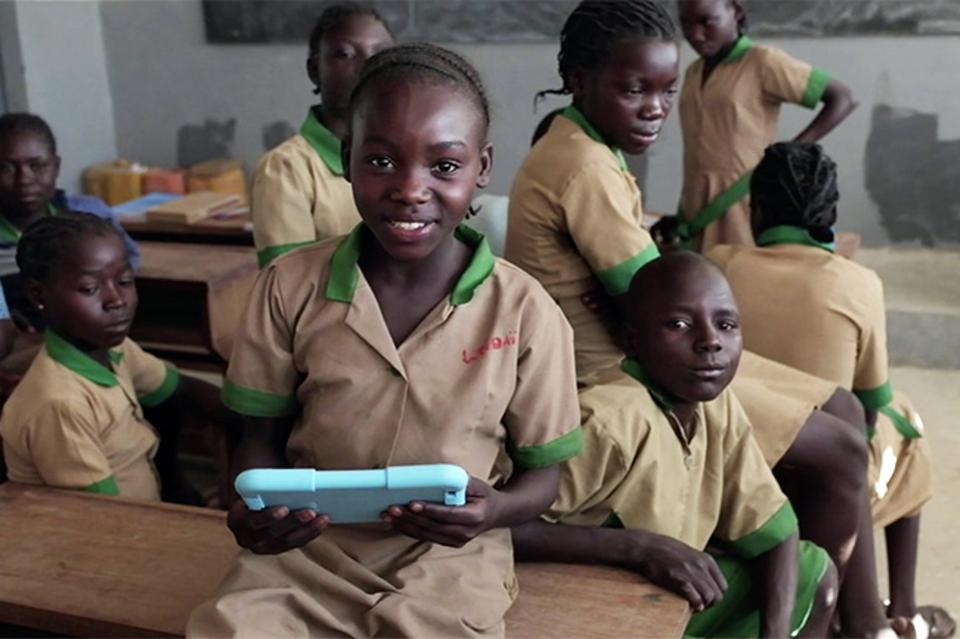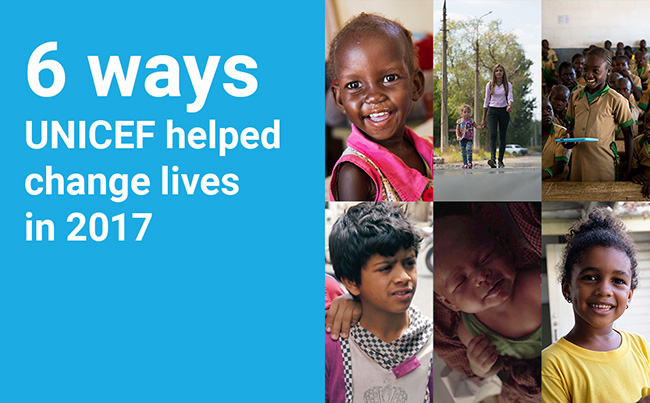6 ways UNICEF helped change lives in 2017
2018-01-17
Looking back on the humanitarian landscape of 2017, it can be easy to focus on the negative: conflicts that show no sign of relenting and with children under attack left with no safe place to go, natural hazards that destroyed millions of homes and lives. But amid the devastation, there are glimpses of hope – girls saved from early marriage, children back in school, and newborns vaccinated against deadly diseases. These moments serve as reminders that with communities, families and children we can make positive change even in the most dire of circumstances. We’ve rounded up six examples of when UNICEF and partners helped improve and save the lives of children this year.

© UNICEF/UN0152308/Gonzalez Farran
Maria's long journey to health
In Feuary of this year, famine was declared in parts of South Sudan. While full-scale famine has so far been averted, the situation is still perilous, with more than a million children likely to be malnourished in 2018. Two-year-old Maria was suffering from severe malnutrition with medical complications when she was admitted to a UNICEF-supported treatment centre. Just one month later, she made a full recovery. Maria is one of the more than 600,000 children who UNICEF and partners have treated over the past four years.

© UNICEF Yemen/2017/Fuad
Bands of volunteers combat cholera in Yemen
In late April, Yemen suffered the world's largest ever outeak of cholera and acute watery diarrhoea that quickly spread across the country as war devastated the water and health systems. Children were particularly vulnerable, making up half of the suspected cases and a quarter of the deaths. To help curb the epidemic and prevent new cases, UNICEF supported community members who mobilized to teach their neighbours how to keep their water, food – and families – safe. “Cholera is a dangerous disease and it kills,” said Fathya. “One of my children got sick, so I wanted to dedicate myself as a volunteer.” Though the epidemic is still deadly, new cases of cholera began to decline in October.

© UNICEF Ukraine/2017/Filippov
Karyna's perilous path to school
Eastern Ukraine is now one of the most mine-contaminated places on earth, endangering 220,000 children who live, play and go to school in areas littered with landmines, unexploded ordnance and other deadly explosive remnants of war. Karyna’s family still lives close to the contact line, and every day on her walk to school she is confronted with the risk of injury or death. She learned how to safely avoid threats through a UNICEF-supported mine risk education campaign.
[su_youtube_advanced https="yes" url="https://www.youtube.com/watch?v=cSlojfiV__8" width="1200" height="675"]
Umar: Born into a refugee camp
When attacks and violence erupted in Rakhine State in August this year, more than 600,000 people fled across the border to Bangladesh. Sixty per cent were children. Umar was born in a refugee camp shortly after his mother crossed the border, and without proper food, they soon became malnourished. UNICEF has intensified its emergency response – including treatment for malnutrition and disease – helping both Umar and his mother make a full recovery.
![On 10 September, 6-year-old Bella Rian Jackson smiles outside the National Technical Training Centre in St. John's, capital of the island of Antigua. The education facility currently shelters displaced families from Barbuda whose homes were destroyed by Hurricane Irma. Bella, from Antigua, volunteers at the shelter with her grandparents, sorting and folding donated clothes, cleaning and tidying up the communal areas, and helping to distribute food and supplies. “I wanted to volunteer with my grandma,” Bella says. “If the children can’t come here, they’d [sic] have nowhere to go, and another storm could come,” she adds. More than 130 people, including scores of children, sheltered at the centre when the facility was at its busiest. On 6 September 2017, Hurricane Irma, the strongest hurricane ever recorded in the Atlantic, pummelled islands in the Eastern Caribbean. The category 5 storm left a path of destruction – especially on Anguilla, the British Virgin Islands, Barbuda and Turks and Caicos Islands. Some 73,000 people in this area, including 20,000 children, are affected, and at least 132 schools have been damaged. Irma disrupted communication networks in many areas and damaged or destroyed infrastructure, including roads, idges, hospitals and schools. The island of Barbuda suffered extensive damage during the disaster. Over 90 per cent of its buildings were destroyed, with homes, schools, the island’s only hospital, and other infrastructure destroyed or severely damaged. A 2-year-old boy was also killed during the storm, and most of Barbuda’s nearly 2,000 residents have been displaced. Officials quickly evacuated the vast majority of the population to Antigua, Barbuda’s sister island, ahead of an anticipated category four hurricane (Hurricane Jose) expected to wreak additional destruction on the already devastated island. Antiguans have rallied to support their compatriots, with church and community groups volunteering at shelters hosting](/wp-content/uploads/4000/01/UN0120231.jpg)
© UNICEF Antigua and Barbuda/2017/English
Children unite to recover from Hurricane Irma
Late summer and early fall of 2017 saw back-to-back hurricanes – Harvey, Irma, Maria – leaving a trail of destruction on the islands of the Eastern Caribbean, Haiti and Cuba. On Barbuda, over 90 per cent of buildings were damaged or destroyed. After losing their homes and schools, the majority of its residents evacuated to Antigua, where they were welcomed with open arms by their compatriots. Bella Rian Jackson, 6, was one of many who volunteered at shelters hosting displaced Barbudan families. “If the children can’t come here they’d have nowhere to go.” UNICEF pre-positioned emergency supplies on the island, and provided educational activities and psychosocial support for children displaced by the storm.

© UNICEF Cameroon/2017
Waibai thrives with digital access
Twelve-year-old Waibai lives in the Far North Region of Cameroon, which has seen regular attacks from Boko Haram. She and her family were forced to flee their home in Nigeria before settling in their current village, where she now attends one of the region’s first connected schools. “I remember the moment I used the internet the first time. It was in January 2017,” she says. “Before that, I didn’t even know what the internet was.” By providing tablets and internet access, UNICEF’s Connect my School programme is helping Waibai and her classmates learn new concepts, while opening up a world of opportunity.










